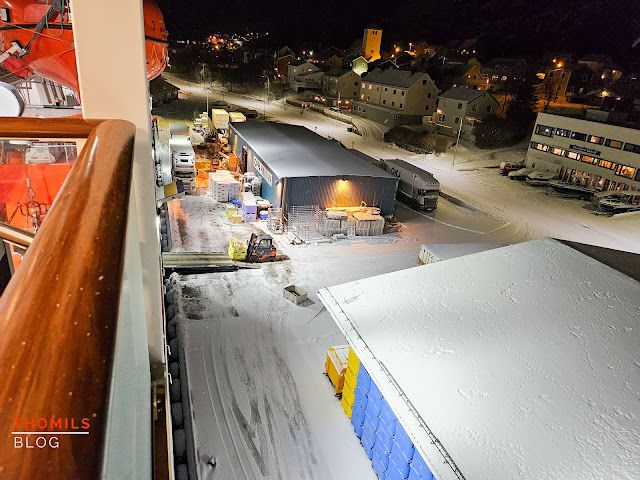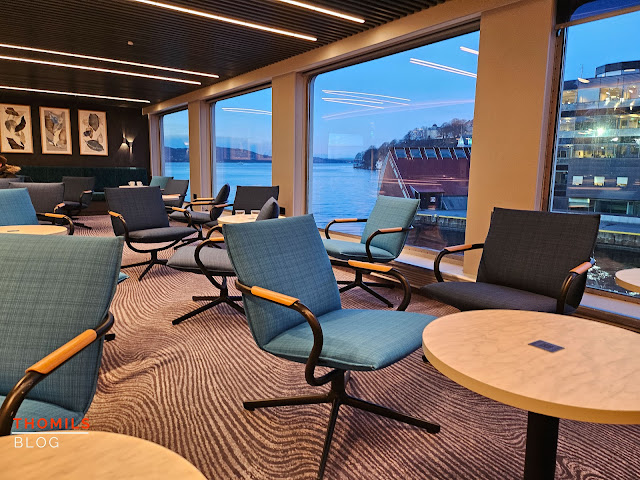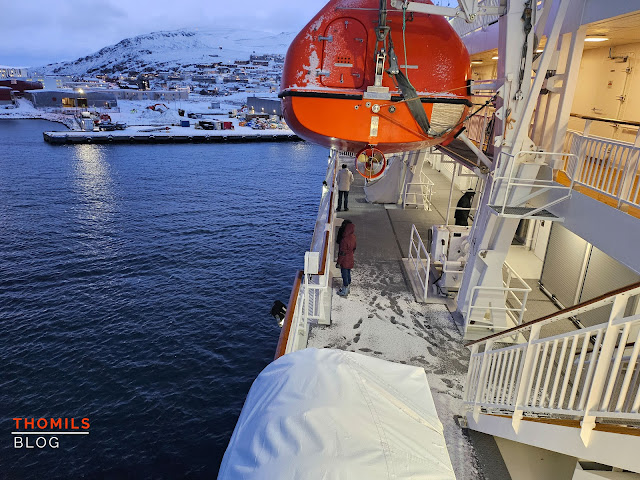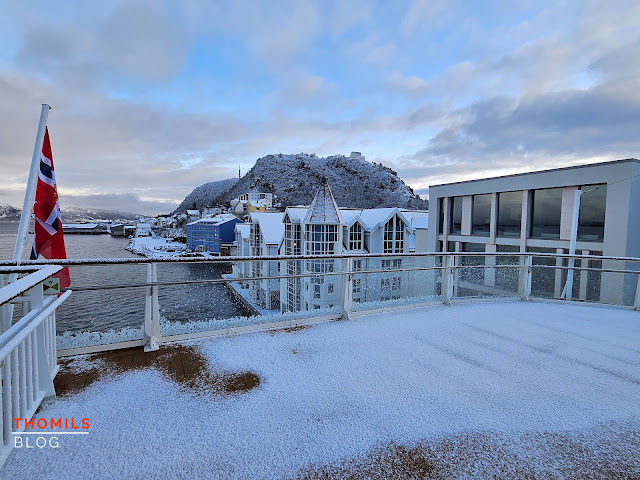Havila Kystruten is the newest player on the Norwegian coastal route. As such, it comes as little surprise that its ships are also the newest ones in service. When Havila was awarded the contract to operate on the coastal route, the Norwegian government decided that it would operate four of the eleven ships on the route, with the remaining seven ships sailing under the flag of incumbent operator Hurtigruten. As a result, Havila ordered a total of four ships that were specially designed for the requirements of the coastal route. Collectively, these ships are known under the type designation Havyard 923, sometimes also referred to as the Capella class, after the first ship of the type to enter service in 2021. My ride to Kirkenes and back would be one of these new ships, Havila Castor, the second ship of the class.
 |
| Havila Castor tied up alongside the quay in Bodø. |
Havila Castor was built at Tersan Shipyard in Altinova, Turkey. She was launched in 2020 in the midst of the pandemic and entered service on the coastal route in May 2022, making her a little over two years old at the time I boarded her in Bergen in November 2024. Like her sister ships, she’s 124 meters long, with a beam, or width, of 22 meters and a draught of 5.2 meters, the latter restricted by the need to pass through the Risøy Channel. Despite her relatively small size, she has a displacement of 15,519 tons.

Despite her conventional looks, all four Capella class ships are equipped with a unique hybrid propulsion system. Rather than running on conventional diesel engines, the ships are equipped with a total of four LNG motors powering two electric motors in stern-mounted drive pods capable of rotating 360 degrees. In addition to powering the electric motors directly, these LNG motors are also used to charge two massive battery banks with a total storage capacity of 6102 kilowatt hours. In regular operation, this allows Havila Castor and her sister ships to reach a maximum speed of 18 knots, with a regular cruising speed of 16 knots. More importantly however, the rotating drive pods, in combination with a pair of fixed bow thrusters, allow the ships to effectively turn on a dime, or whatever the Norwegian counterpart is. Most crucially however, the twin battery banks allow the ships to run only on her electric engines for a total of four hours. This allows Havila ships to enter ecologically sensitive areas such as Geirangerfjord or Trollfjord whilst effectively running silent. Given the increasingly strict environmental restrictions in Norway, this gives Havila a distinctive advantage over Hurtigruten, who are currently having to refit their coastal vessels at considerable expense.
 |
| The passenger gangway is crucial for the many barebones ports that Havila Castor and her sister ships serve along the coastal route. |
 |
| The cargo hatch on the port side aft of the ship is regularly used transport supplies to smaller ports or, as in this case, take onboard cargo to be transported to a larger city. All cargo is loaded with forklifts. |
But Havila Castor is more than just an impressive drive system. She’s a coastal ferry that needs to provide a reliable service to the communities along the hurtigrute. As such, she has a cargo hold with a maximum capacity of 190 pallets of freight, 40 of which are in a dedicated refrigerated hold. There are also a total of five spaces for private cars. This cargo hold spans most of the aft parts of Decks 2 and 3 and is accessed by a dedicated cargo ramp on the ship’s port aft quarter.
Deck 4
 |
| In most ports, this is the primary way to board the ship. The gangway leads to a short flight of stairs up to the reception on Deck 4. |
 |
| The Reception on Deck 4 is manned 24 hours a day. |
The passenger experience meanwhile starts on Deck 4. Amidships on the port side is the passenger boarding ramp which is used for boarding and disembarkation in all ports not called Bergen. This passenger ramp leads directly into the reception area on Deck 4, at the bottom of an atrium that spans all the way up to Deck 8. The majority of Deck 4 however is taken up by inboard and outboard cabins, as well as a dedicated sleeper chair lounge for port-to-port passengers. The ship’s sick bay and an array of customer accessible washing machines are available on Deck 4 as well. These are available free of charge.
Deck 5
 |
| This seating area surrounding the ship's central atrium is effectively the only non-cabin part of Deck 5. This is also the first part of the ship you see when boarding in Bergen. |
Deck 5 is effectively more of the same. Most of the deck is taken up by passenger cabins, as well as a small seating area surrounding the atrium. More importantly though for passengers beginning their trip in Bergen, Deck 5 is also where you’ll board the ship from the gangway at the city’s Jekteviksterminalen. There’s a dedicated boarding door available for this on the port side.
Deck 6
 |
| All the way forward on Deck 6 is the wraparound bow lounge. The faux fireplace seen here is mirrored over on the port side. |
 |
| The seats near the fireplaces are some of the most prized places on the ship, even though there's no heat emanating from said fireplace. Open fire is naturally banned onboard for safety reasons. |
 |
| Walkways lead aft from the bow lounge on both the port and starboard side. |
 |
| Each of these corridors also sports a coffee station where cruise passengers can help themselves to complementary tea, coffee, or chilled water. |
 |
| Right aft of the bow lounge, you'll find the conference room. This is used by the onboard expedition team for daily presentations about the ports ahead, the area the ship is sailing through, any points of interest, and warn of areas of open ocean or rough seas. |
 |
| Right aft of the conference room is the ship's shop, which stocks all kinds of travel essentials, souvenirs and clothes that are just too small for someone like me! |
 |
Right aft on Deck 6, you'll find Harvard restaurant, the ship's main dining room.
|
 |
| Forward of Havrand on the ship's port side is Hildring, the ship's fine dining restaurant. |
 |
| Meanwhile, Havly, on the starboard side of Deck 6 is the opposite of Hildring, providing high quality down-to-Earth comfort food! |
Things get much livelier on Deck 6, which is pretty much the social hub of the ship. Almost the entirety of this deck is taken up by public spaces. Starting forward, this encompasses the bow lounge, which wraps around the entire forward part of the deck and also provides access to the fo’c’s’le, if the weather cooperates that is. Moving aft, the sides of the ship are taken up by additional lounge space, whilst sandwiched within that are the ships conference/briefing room and the onboard shop. This area of the ship also houses two fresh water dispensers as well as complementary free coffee machines. They also provide hot water for those who prefer their drinks to consist of drowned leaves. Immediately aft of the shop is the central atrium, which also houses the desk for the onboard excursion team. Aft of the atrium, the port side of Deck 6 houses Hildring, Havila’s fine dining restaurant, whilst the starboard side houses the Havly Café, which is mainly used by port-to-port passengers. Continuing aft on the starboard side, you’ll reach the head waiters desk, which lords over the entrance to Havrand, the main restaurant aboard. This wraps around the entirety of the stern of the ship on Deck 6, whilst the panoramic windows allow for panoramic views even if you don’t have a table by the window.
Deck 7
 |
| This is the best view I can give you of the outside areas of Deck 7. Given that it houses the ship's gyms, I stayed well away from it! |
Deck 7 is effectively the counterpoint to this. Amidships, next to the ship’s atrium and lifts, you’ll find the ship’s two gyms, as well as access to the outdoor boat deck. The forward and aft portions of this deck are taken up chiefly by the ship’s junior and balcony suites as well as a raft of interior cabins.
Deck 8
 |
| Deck 8 is mostly an outdoor facility, with public decks stretching all the way to the stern of the ship. |
 |
| Havbris, the ship's outdoor bar, is also located here. When I was aboard, it was only used for special events. |
 |
| Just forward of the central atrium, Deck 8 sports two covered and protected outdoor nooks, on on the port side and one on the starboard side, which also pull double duty as the ship's only smoking area. |
 |
| Nearly all the way aft on Deck 8, you'll find the ship's two hot tubs. No, I didn't use them, although they saw frequent use during the trip. |
Deck 8 is primarily an outdoor deck, although it does also host the ship’s two premier “Lighthouse Suites”, the highest-class cabins aboard, each with its own personal balcony and hot tub. Speaking of hot tubs, all Capella class ships sport two public hot tubs out in the open on the aft end of the deck. Slightly forward of this, you’ll find Havbris, the ship’s only outdoor bar whilst both the changing rooms for the hot tub as well as two saunas are situated just forward of that. It’s also worth noting that, while not accessible to the public, the ship’s bridge is located all the way forward on this deck.
Deck 9
 |
| Havblikk, the bar in the panorama lounge on Deck 9, offers the best views on the entire ship. |
 |
| It's hard to explain just how cozy it is to sit up here and watch the freezing landscape pass by outside. |
 |
| The rest of Deck 9 is basically just a wraparound external walkway. |
Finally, Deck 9 is the highest publicly accessible point of the ship. Like Deck 8, it is primarily and outdoor deck, consisting chiefly of a wraparound panorama deck that wraps around the entire ship, including the glass-clad indoor panorama lounge and bar called Havblikk. This lounge, which I took to calling Ten Forward because of its similarity to a crew lounge on a certain Galaxy class starship, is quite simply the most spectacular place on the ship, although it is prone to a lot of movement in rough seas. It’s also worth noting that the ship’s horn is only slightly above Deck 9, so if you’re sensitive to loud noises, this is something to keep in mind, particularly when entering port or passing another ship on the coastal route.
Whichever deck you’re on, the entire ship is fit out in a modern Nordic (no surprises there) style the emphasises calm and comfort. You’ll find no bright advertisements, loud music blaring out of bars, or garish colours on this ship. Instead, natural wood tones and muted earthy hues dominate the interior, with local artists, placards outlining the history of Havila and the coastal routes, as well as photographs of the stunning landscape along the route taking pride of place. The combination of materials and colours gives the entire ship a relaxed, calm ambience. Above all however, everything is designed with practicality in mind. Remember, these ships are coastal ferries first and foremost, their tourist offerings are of secondary importance.
Cabin - Deck 4

This combination of understated décor and practical design extends to the cabins. I was accommodated in Cabin 4309, a Seaview Superior cabin on the port side of Deck 4, just aft of the cargo hatch. Not only is the cabin surprisingly big for two people, it also sports a small sofa and coffee table, the latter of which can be freely positioned or moved out of the way as needed, whilst the former can be converted into another bed if required, increasing the capacity of the cabin to four people. One of the cabin walls holds a desk with a drawer and some shelving for personal items, with the shelving having some high sides to prevent stuff from flying around the cabin during rough seas. Meanwhile, the space underneath the main bed is large enough to accommodate most suitcases. The closet & wardrobe is a bit on the small side but is still okay. Everything is furnished either in light wood tones or pastel greys that, for once, don’t feel depressingly lifeless. All in all, it’s a great cabin, and a great ship, for a journey of a lifetime!





























Comments
Post a Comment